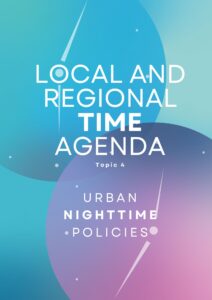Urban nighttime policies
Local and Regional Time Agenda

Two decades ago, France, Italy, and Spain introduced time policies to improve the lives of their citizens by navigating urban rhythms and coordinating local services. However, the approach focused on organizing social time, particularly during daylight hours. This interest was justified: local services from mobility to service provision are primarily centred on the daytime. And when dealing with new proposals on urban time, such policies tend to look at how citizens use urban spaces — or, put differently, how urban habitats are created and used for, and intersect with, varying needs — during the various hours of the day. But a day lasts longer than its hours of daylight, and policies regulating uses of urban spaces also should embrace a nocturnal dimension.
It is therefore no surprise that the night has come to demand the attention of time policies and prompted local and regional governments to address it. But this attention is fragmented, with sector-specific policies that, though important, neglect particular patterns of nighttime use. As varied as nocturnal time policies can be, they must approach this subject holistically. This entails not only considering how citizens, particularly minorities, use, work in and enjoy urban spaces at night, but also identifying the stakeholders involved during these hours and how public administrations deal with intersecting needs in nocturnal urban life.
This Agenda presents 18 nighttime-related public policies implemented at various levels of urban governance that are already changing the urban night for the better. These are complemented by insights from experts, academics, and practitioners like Andreina Seijas, Jakob F. Schmid, and Jordi Nofre. Together, they offer a preface to understand the varying dimensions of how nighttime policies can be conceived and replicated.




